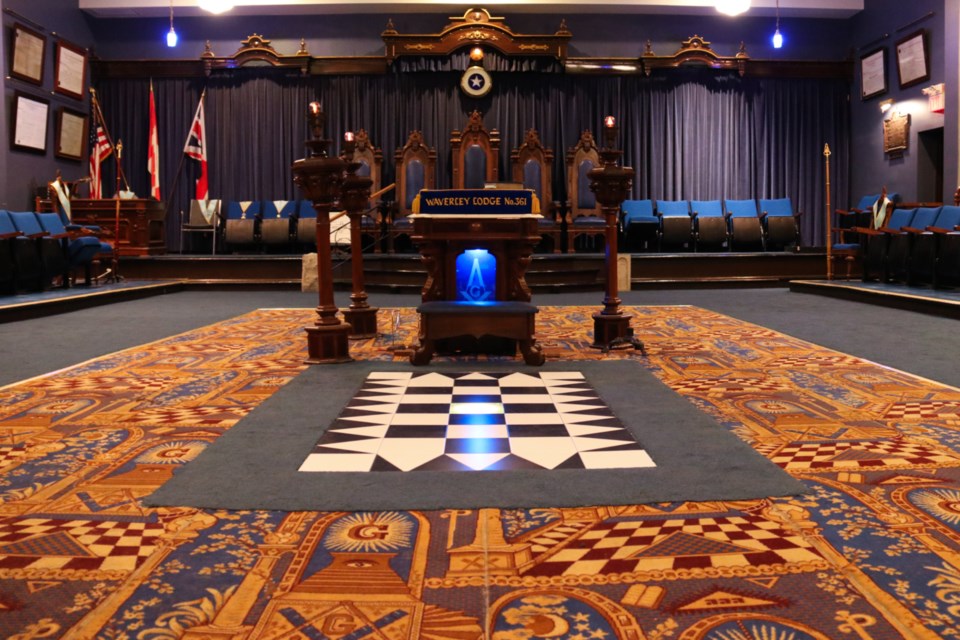The Masonic Temple is shrouded in hundreds of years of mystery and myth. But Saturday, the Guelph temple opened its doors to give the public a peek behind the curtain.
Perhaps you think of the Masons as a clandestine, cloak and dagger type of organization that plays politicians like puppets.
“But that’s not how this works,” said Mason Rob Gray of Waverly Lodge 361 of the fraternity.
“There’s a bit of a joke. If you think Masons rule the world, you should see them try to put together a barbecue. We’re not that much of a threat,” he said during a walking tour of the temple.
The temple, located inconspicuously on Chapel Lane, was part of Doors Open Guelph, which saw several buildings open up their doors to the community with free guided tours.
Masons in Guelph date back to 1849 with the first temple on Wyndham Street.
The fraternity is a journey in a sense, one aimed at making men better than they were before.
Its current location was built in 1860 and became the new Masonic Centre in 1914. The building saw $1 million in renovations in 2000, to modernize it while retaining its original limestone walls.
The Masons own the building and rent to the stores below.
Today there are around 350 Masons in Guelph, and six local lodges.
Of the six, the Speed Lodge 180 is the oldest, formed in 1866. The newest, the Royal City Daylight Lodge 742 formed in 2000 to accommodate aging membership with earlier meetings and more emphasis on socializing.
The most notable rooms are the red room, often used for plays and blue room, used for general meetings. Each room is covered in red and blue carpet. The chairs, walls, curtains, and pretty much everything else, are also decorated red or blue.
The blue room has additional ornamental carpet that was designed by a Mason and manufactured in Guelph specifically for the room, with intricate patterns woven on a jacquard loom and hand-stitched.
The wooden furniture in the room was brought from the old lodgings on Wyndham Street, made by Armstrong Furniture.
There are two stones in the blue room in front of the Worshipful Master’s chair (a Worshipful Master is sort of like a chapter president): the rough ashlar (a rough, unfinished stone) and the perfect ashlar (a more polished brick), representing “what a man is when he joins and what he ought to be when he’s done.”
To become that polished stone, Masons go through degrees, each one representing a moral.
There are three groupings: the Lodge of Perfection (degrees four through 14), the Chapter of Rose Croix (degrees 15 through 18) and the Consistory (degrees 19 through 32).
Degrees can be earned through watching or participating in morality plays with costumes, makeup – the gamut. But candidates won’t know if they’re participating until someone leads them onstage.
“We will take you, put you in a costume,” Mason Gary Stewart of Wilmot Lodge 318 said, adding that they might be blindfolded.
“You might put on some sandals. It could be like you’re walking through the desert,” he said.
But everyone gets a degree just for witnessing the play, even if they didn’t participate – which is why the plays aren’t open to the public.
Some are biblical, some aren’t.
The first two groupings are performed in the red room, but the Consistory plays require more room, props, and costumes than the Guelph temple has, and are performed at a larger theatre room in Hamilton.
For instance, he said one of the Consistory plays might have 56 costumed players involved, using swords and wearing helmets.
“It could be monks versus monkeys, it could be kings. Just about anything you can think of,” he said.
A number of prominent Guelphites have been Masons, including Colonel David McCrae, Alexander Petrie, James Goldie, William Tytler, a number of Guelph mayors, the creator of the Yukon Gold potato Garnet Johnston, and many more.
Perhaps the most notable of them all was George Drew, who was former mayor of Guelph, the 14th premier of Ontario, and former leader of the Progressive Conservative Party and Leader of the Official Opposition.
“Freemasonry didn’t produce these (men), but each of them believed that their involvement in their lodge was meaningful and worthwhile,” Gray said.
